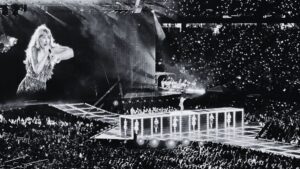Retail operational efficiency is a driving force of successful stores. It can make or break the shopping experience for customers and can decide the fate of your bottom line.
By embedding best practices into your store operations, from inventory management to store layout, you not only streamline processes but also supercharge employee performance and customer satisfaction.
Our guide delves into efficient retail operation strategies, challenges, and how you can take your store to the next level. Let’s dive into everything you need to know to elevate your retail operation efficiency.
At pass_by, we offer the highest in market accuracy with 94% correlation to ground truth, over 15 data inputs, and a full 90 days of predictive feeds. Book a call now.
What is operational efficiency in retail?
The meaning of operational efficiency is an optimization of a retail store(s) to be cost-effective, increase sales, reduce costs, and improve customer service. Achieving better operational efficiencies is key to meeting sales targets
Higher operational efficiency for customers means better product availability and improved shopping experience.
How can retail operations be improved?
The three main factors that impact operational efficiency are:
- Utilising resources
- Inventory management
- Manufacturing
Examples of efficient retail operations include using automation for accuracy, indexes, and customer satisfaction levels. There are many indicators of efficiency that retailers collect to report on and improve how a store operates.
Improving operational efficiency takes time and effort. To improve operations, try following these steps:
- Step 1: Evaluate current performance.
- Step 2: Find time-consuming tasks. Identify which manual labor tasks are unnecessary or can be reduced, depending on the level of benefit they provide to the shopping experience.
- Step 3: Consider automation. Automating emails, data entry, and other tasks can reduce costs and let employees focus on other tasks.
- Step 4: Focus on customer experience. Set up training processes on new protocols and ensure customer satisfaction is a priority.
Depending on the type of store you have and the inefficiencies you find, your steps could look different. The key is to have patience and continue measuring operational efficiencies to adjust as needed.
Essential retail operations best practices
As you begin the process of optimizing your operations, keep best practices in mind to ensure your store achieves its goals faster.
Best practices for retail operations include good inventory management, an updated point-of-sale system, a clear store layout, an organized behind the scene area, and a clear set of goals from an industry benchmark.
1. Inventory management
Inventory management is the process of how you order, store, and sell your products. Inventory management is the backbone of efficient retail operations. A well-maintained inventory ensures your store is stocked with products to meet consumer demand. This, in turn, enables you to keep your customers satisfied while maximizing your revenue potential.

Good inventory management goes beyond merely tracking products. It requires an understanding of sales trends, seasonal fluctuations, and customer preferences. This lets you make accurate forecasts, avoiding excess stock or shortages that could harm sales and customer relations.
In essence, effective inventory management translates into smooth retail operations, remarkable customer service, and a robust bottom line. As click-and-collect sales grow by 19.4% in the US, good inventory management is more important than ever.
2. Point-of-Sales systems
Every retailer has a Point-of-Sales system (POS). These are the systems of how your store accepts payment, including cash, contactless, credit, and debit cards.
Steps in optimization can include connecting your POS system to other business software such as e-commerce platforms, accounting software, and email marketing services. This further cuts down manual labor by automating vital aspects of your business operations in these areas.
Finally, always update your POS system to the latest version to take advantage of new features and improvements. It enhances system stability, secures customer data, and speeds up transaction times.
Training on any new POS hardware and software systems will also boost your team’s confidence and cut down on time wastage.
3. Store layout
An efficient store layout guides customer foot traffic throughout your store. It’s one of the few areas that’s fully within your control.
A well-planned layout can contribute to better product visibility, improved flow of foot traffic, and enhanced shopping experiences for customers. It’s all about making your retail store as navigable, visually appealing, and shopper-friendly as possible.
Depending on your store and stock, this could mean:
- Strategic product placements and offers
- Using easy-to-read, clear signs throughout the store
- Intuitive paths for customers to follow
Positioning your products strategically directly impacts sales. Locations with the highest visibility often house high-demand or impulse-buy items. By clustering related products together in a logical, intuitive fashion, you cater to the customers’ convenience and potentially boost sales.
Remember, an efficient store layout isn’t about filling every inch of your retail space with inventory. It’s about making the shopping experience enjoyable and effortless, resulting in happy customers and improved sales.
4. Organize behind the scenes
What the customer sees isn’t the only part of your retail operations. Anything behind the scenes such as your back office needs to be efficient as well.
Improve efficiency in your behind the scenes spaces by:
- Developing an easy-to-navigate stockroom for staff to find items quickly
- Regular cleaning and decluttering
- Staff training on organization and stock management
Implementing these practices will help improve the efficiency and effectiveness of your store’s back-end operations, so you can enhance the overall retail experience.
5. Know your numbers
Making your store more efficient can increase its performance. But make sure to set expectations within industry benchmarks.

Industry benchmarks can be set by comparing your competitors. You can do this using raw data yourself or by using a reporting tool such as Almanac.
Almanac can also provide 90-day foot traffic predictions using machine learning developed by NeuralProphet (Stanford Ph.D. candidates). These 90-day predictions can set expectations of sales performance and help you manage inventory. Knowing your numbers, whether ones from previous months or even ones that haven’t happened yet, can help you improve operations across the board.
Use Almanac to create a foot traffic benchmark report and set expectations for your store now.
Challenges of operational efficiency examples and how to overcome them
When trying to improve store operations, you will likely face some hurdles. Some examples of challenges you may face when trying to achieve higher efficiency are:
- Lack of accurate data
- Lack of cohesion across the company
- Employee turnover
- Manual labor
1. Lack of accurate data
Accurate data is key to understanding what is happening in store and to identify the weak points to improve efficiency.
For example, if foot traffic is high or average compared to industry benchmarks, then displays in-store could be suboptimal.
Miscalculations and inaccurate data, either from human error or poor data sources, have a big impact on your business’s efficiency.
2. Lack of cohesion across the company
Poor communication leads to decreased performance. A lack of cohesion across the company can throw a wrench in a retail store’s operational efficiency.
This is primarily because cohesive teams work in unison, collaboratively solving problems, and efficiently driving the business forward. A company where departments or individuals function in isolation from one another drastically impedes this process.
Imagine a scenario where the store’s merchandise department isn’t aligning with the marketing team’s promotional calendar.
The result? You could end up with a large-scale marketing campaign promoting items that are not yet in store, causing customer frustration and loss of sales.
Inefficient coordination can be costly, damaging credibility and hurting the bottom line. If you discover a lack of communication and cohesion, make fixing it a priority.
3. Employee turnover
Employee turnover is the rate at which employees leave a company. A high turnover rate can spell disaster for retailers as it means higher costs, decreased productivity, and knowledge loss from experienced employees leaving.
Recruiting new employees and training them can be costly. Additionally, a high turnover rate can decrease employee morale as the lack of stability and constant training drains their energy.
4. Manual labor overload
Too many manual labor tasks can significantly impede a retail store’s operational efficiency. On average, retail employees spend 30-40% of their time on non-selling activities.
Retail stores heavily rely on manual labor for most in-store activities, from stocking shelves and inventory control to cashier duties and customer service.
These tasks can be time-consuming, labor-intensive, and often inconsistent in their execution due to the human element involved. This certainly can hinder a store’s capacity to operate at its maximum potential.
Ways to reduce manual labor workload include employee training and task automation when possible.
What is a common way retailers measure store operations?
Retailers measure store productivity primarily through a calculation. Calculate your business’s efficiency is by using this calculation:
Total revenue / operating expenses = current operational efficiency.
For example, if a business’s total revenue for 2023 was $250,000 with operating expenses of $125000, then the business would have an operational efficiency ratio of 0.5.
Your options are to increase revenue or decrease expenses. Ideally, aim to achieve both for optimal operations.
Why retail operations are important
But why spend all this time trying to improve store operations? Because improving retail store operations means multiple benefits. See our list of reasons to make an impact on your efficiencies below.
1. An efficient workplace keeps its employees
Employees want training and development. Keeping your staff engaged via mutually beneficial training sessions can improve employee engagement by 27%.
Automating repetitive tasks such as data entry also allows your staff to focus on tasks they truly value, while driving value to the business. These results further motivate employees.
2. Customers expect it
70% of customers now expect a seamless shopping experience across all channels. Imagine you’re a customer and walk into a brick-and-mortar store. Common expectations are:
- Helpful staff
- Quality products
- Orderly shelves
- A clean store
- Short waiting times at checkout
- Easy store navigation
- Accurate inventory
- Prompt customer service
Inefficient operations can cripple all of the above and reduce customer satisfaction.
Online shopping has heightened expectations for retail efficiency as digital stores can offer fast shipping and personalized experiences. Stores must have high efficiency to remain competitive.
3. Reduce costs
Higher costs mean less cash to invest in improving your business, rewarding employees, and expanding your business.
A study by McKinsey found retailers were “removing up to 30% of costs in store operations and corporate-support functions by applying lean techniques and accelerating offshoring.” One retailer even reduced costs by over 40% in several expense categories.
Reducing costs can often mean reducing waste. Find where money may be going to waste, reduce expenses, and your business will be more efficient.
How can you make a retail store efficient for an omnichannel experience?
The goal of omnichannel retail is to give customers a convenient and seamless shopping experience across every channel from online to offline.
Omnichannel retail strategies allow customers to shop on their preferred channel and explore your brand at their convenience whether they are browsing through your eCommerce website, mobile app, or physical store locations.
So, what steps can you take to make your retail store efficient for an omnichannel experience? Here they are:
- Implement an order management software system. These systems handle orders seamlessly across all channels to eliminate the need for multiple tracking systems. Your system should provide real-time order tracking to notify you and your customer of any changes.
- Clear returns process. 8% of orders are returned, so having a clear returns system is more important than ever. A good policy also addresses customers’ concerns and makes them more likely to buy.
- Omnichannel training. When customers visit your store, they may need help with your store’s app, making a payment, or completing a product return. Ensuring staff are knowledgeable about these processes makes for a seamless experience.
What is most important for efficient store operations?
The most important thing for efficient store operations lies in the data you have at your disposal.
Streamlining your daily processes, organizing your storage, and even altering your store layout are all fantastic steps but data is the foundation of all decision-making. Without accurate and precise data, efficient operations can’t be achieved as you would be using inaccurate measurements.
At pass_by, we offer the highest in market accuracy with 94% correlation to ground truth, over 15 data inputs, and a full 90 days of predictive feeds. Book a call now.





